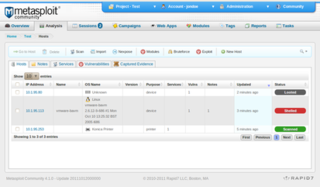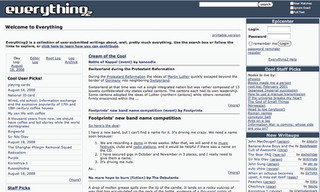
Nathan Oostendorp is an American technologist, author, and entrepreneur. He is from Holland, Michigan and is a co-founder of the technology news website and community Slashdot and founder of the online community Everything2.

Nathan Oostendorp is an American technologist, author, and entrepreneur. He is from Holland, Michigan and is a co-founder of the technology news website and community Slashdot and founder of the online community Everything2.
Oostendorp was a contributor and content editor of Slashdot as well as an author of the SlashCode software—Slashdot's freely licensed technological platform. He was a founder of the firm Blockstackers Intergalactic (BSI) which managed and developed the website.[ citation needed ] [1] In addition to his work on Slashdot, Oostendorp's work at BSI included the creation of the early online encyclopedia project Everything2, [2] and the Perl programming web community PerlMonks which used the Everything Engine. After the sale of BSI to Andover.net and subsequently to VA Linux Systems (which became Geeknet), Oostendorp worked as a developer and manager at the free software and open source hosting platform SourceForge.
Oostendorp has a master's degree in Information Economics from the University of Michigan School of Information. While at Michigan, he published several academic papers based on his experience with online communities. [3] [4] [5]
Oostendorp founded the Ann Arbor, Michigan-based Internet of Things startup Sight Machine [6] (formerly Ingenuitas) focused on industrial applications of computer vision techniques. [7] He is the author of the software SimpleCV [8] and holds a patent related to computer vision. [9]
In software development, obfuscation is the act of creating source or machine code that is difficult for humans or computers to understand. Like obfuscation in natural language, it may use needlessly roundabout expressions to compose statements. Programmers may deliberately obfuscate code to conceal its purpose or its logic or implicit values embedded in it, primarily, in order to prevent tampering, deter reverse engineering, or even to create a puzzle or recreational challenge for someone reading the source code. This can be done manually or by using an automated tool, the latter being the preferred technique in industry.

Perl is a high-level, general-purpose, interpreted, dynamic programming language. Though Perl is not officially an acronym, there are various backronyms in use, including "Practical Extraction and Reporting Language".
Slashdot is a social news website that originally billed itself as "News for Nerds. Stuff that Matters". It features news stories on science, technology, and politics that are submitted and evaluated by site users and editors. Each story has a comments section where users can add online comments.

Simple DirectMedia Layer (SDL) is a cross-platform software development library designed to provide a hardware abstraction layer for computer multimedia hardware components. Software developers can use it to write high-performance computer games and other multimedia applications that can run on many operating systems such as Android, iOS, Linux, macOS, and Windows.

Randal L. Schwartz, also known as merlyn, is an American author, system administrator and programming consultant. He has written several books on the Perl programming language, and plays a promotional role within the Perl community. He was a co-host of FLOSS Weekly.
SourceForge is a web service that offers software consumers a centralized online location to control and manage open-source software projects and research business software. It provides source code repository hosting, bug tracking, mirroring of downloads for load balancing, a wiki for documentation, developer and user mailing lists, user-support forums, user-written reviews and ratings, a news bulletin, micro-blog for publishing project updates, and other features.
This page provides an index of articles thought to be Internet or Web related topics.

Computer accessibility refers to the accessibility of a computer system to all people, regardless of disability type or severity of impairment. The term accessibility is most often used in reference to specialized hardware or software, or a combination of both, designed to enable the use of a computer by a person with a disability or impairment.
PerlMonks is a community website covering all aspects of Perl programming and other related topics such as web applications and system administration. It is often referred to by users as 'The Monastery'. The name PerlMonks, and the general style of the website, is designed to both humorously reflect the almost religious zeal that programmers sometimes have for their favorite language, and also to engender an atmosphere of calm reflection and consideration for other users.

OpenCV is a library of programming functions mainly for real-time computer vision. Originally developed by Intel, it was later supported by Willow Garage, then Itseez. The library is cross-platform and licensed as free and open-source software under Apache License 2. Starting in 2011, OpenCV features GPU acceleration for real-time operations.
In computing, a solution stack or software stack is a set of software subsystems or components needed to create a complete platform such that no additional software is needed to support applications. Applications are said to "run on" or "run on top of" the resulting platform.

Catalyst is an open-source web application framework written in Perl. It closely follows the model–view–controller (MVC) architecture and supports a number of experimental web patterns. It is written using Moose, a modern object system for Perl. Its design is heavily inspired by frameworks such as Ruby on Rails, Maypole, and Spring.

The Metasploit Project is a computer security project that provides information about security vulnerabilities and aids in penetration testing and IDS signature development. It is owned by Boston, Massachusetts-based security company Rapid7.

Everything2 is a collaborative online community consisting of a database of interlinked user-submitted written material. E2 is moderated for quality, but has no formal policy on subject matter. Writing on E2 covers a wide range of topics and genres, including encyclopedic articles, diary entries, poetry, humor, and fiction.

In computing, a script is a relatively short and simple set of instructions that typically automate an otherwise manual process. The act of writing a script is called scripting. Scripting language or script language describes a programming language that it is used for scripting.
Mojolicious is a real-time web application framework, written by Sebastian Riedel, creator of the web application framework Catalyst. Licensed as free software under the Artistic License v 2.0, it is written in the Perl programming language, and is designed for use in both simple and complex web applications, based on Riedel's previous experience developing Catalyst. Documentation for the framework was partly funded by a grant from The Perl Foundation.
The following outline is provided as an overview of and topical guide to the Perl programming language:

Intel RealSense Technology, formerly known as Intel Perceptual Computing, is a product range of depth and tracking technologies designed to give machines and devices depth perception capabilities. The technologies, owned by Intel are used in autonomous drones, robots, AR/VR, smart home devices amongst many others broad market products.